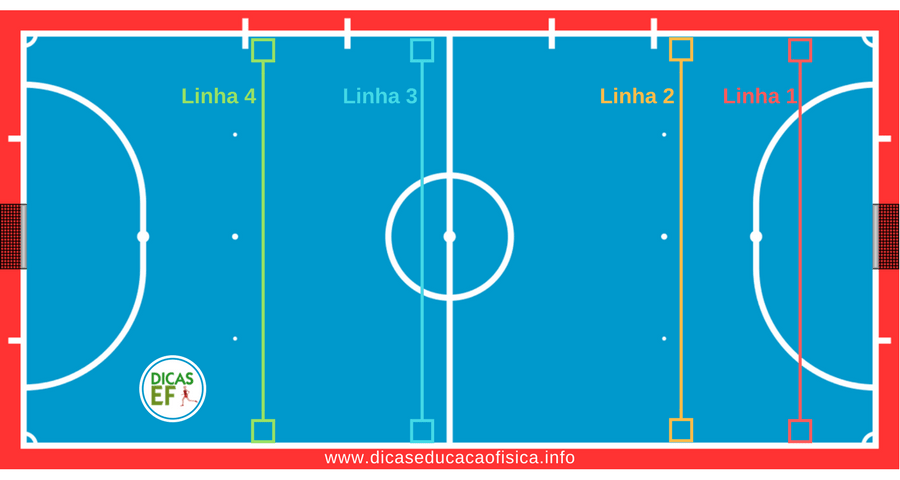Introduction: Futsal Tactical System
In Futsal Tactical System, The DEF presents the tactical systems and concepts of Futsal. We will talk about futsal offensive systems, futsal defensive systems, types of marking in Futsal and futsal defensive lines.
FUTSAL OFFENSIVE TACTIC
The Futsal offensive tactic is the way how a Futsal team positions itself on the court with possession of the ball to create attacking moves.
HOW TO CHOOSE AN OFFENSIVE SYSTEM?
The choice of the Offensive System for a Futsal team must based on the characteristics of the players that form the team. If you are a Futsal coach, do not try to impose a tactical scheme on your team without taking into account the characteristics of your players.
Before choosing your offensive system, answer the following questions:
-
Against which team are you playing?
-
What are the characteristics of the players on your team?
-
What is the physical condition of the players on your team?
Note! When the team is attacking the tactical organization is important, however, due to the great movement for the occupation of the space, there should not be a rigidity in the positioning of the players in the offensive movement.
Below we will make an analysis with the advantages and disadvantages of the main offensive systems of Futsal.
Futsal Offensive System 3×1 or Diamond
This is one of the most common systems in Futsal, it provides a balance between defense and attack. It has a player dedicated to the attack (the Pivot), while there is also a player dedicated to the defense (the defender). There are also two wingers, the right winger and the left winger that must support both defense and attack.
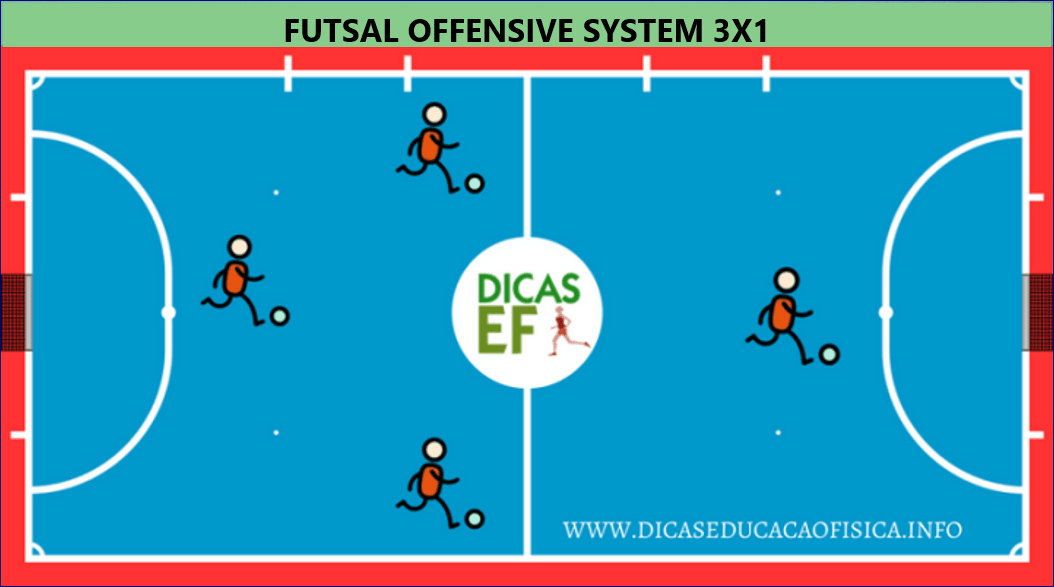
Advantages of the 3×1 System:
There is a specialized player on defense and specialized attack player;
The team is more compact both to defend and to attack.
Disadvantages of the 3×1 System
If both wingers focus too much on the attack, will leave the defense very exposed and defender overloaded;
It can also overload the Pivot, if the wingers have offensive difficulties.
Futsal Offensive System 2×2 or Square
The tactical system of Futsal 2×2, also known as “Square”, basically divides the four players of a team in the two main areas of responsibility: defense and attack. It is a simple system that can help to develop good pairs of defenders and attackers.
Although two players are advised to be more advanced (in attack) and two to be further back (in defense), these roles will need to be very flexible, as attackers will need to help the defense and vice versa. In addition, most teams attack and defend with at least three players.
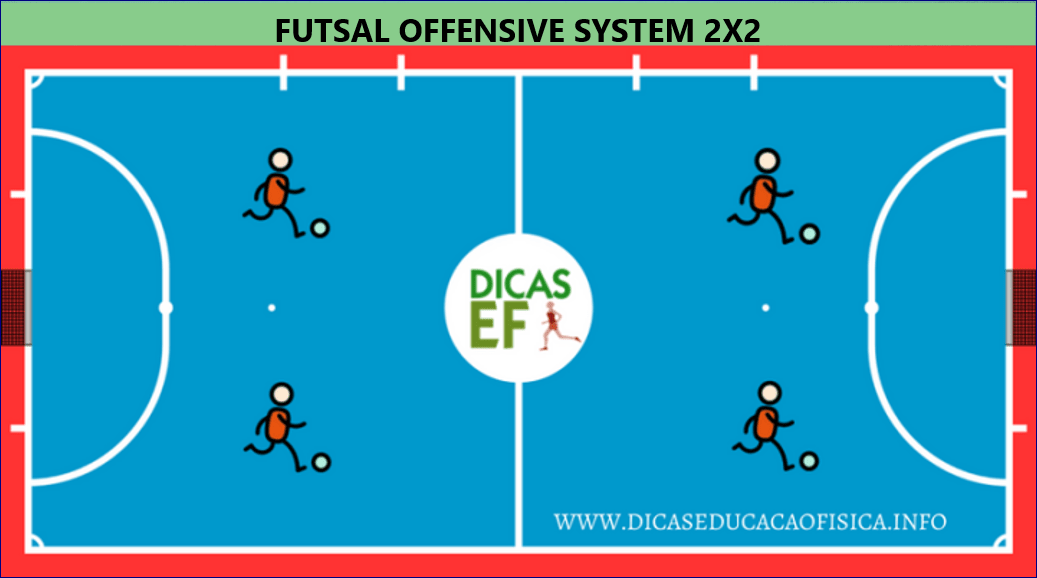
Advantages of the 2×2 System in Futsal
- Great system for beginners;
- Gives balance between attack and defense;
- Ensures that the defense and the attack have at least one player all the time.
Disadvantages of the 2×2 System in Futsal
- Restricts players’ movement;
- Can be defensively weak if defenders join the attack and attackers are unwilling to perform defensive functions;
- If the team is poorly trained or does not communicate well on the court, there may be confusion between which attacker should support the defense and which defender should support the attack.
Futsal Offensive System 4×0
Futsal 4×0 tactical system is used by high level teams, like professional teams. The idea is to have all 4 players moving at once, promoting a move that allows many options for passes, space occupation and attack opportunities.
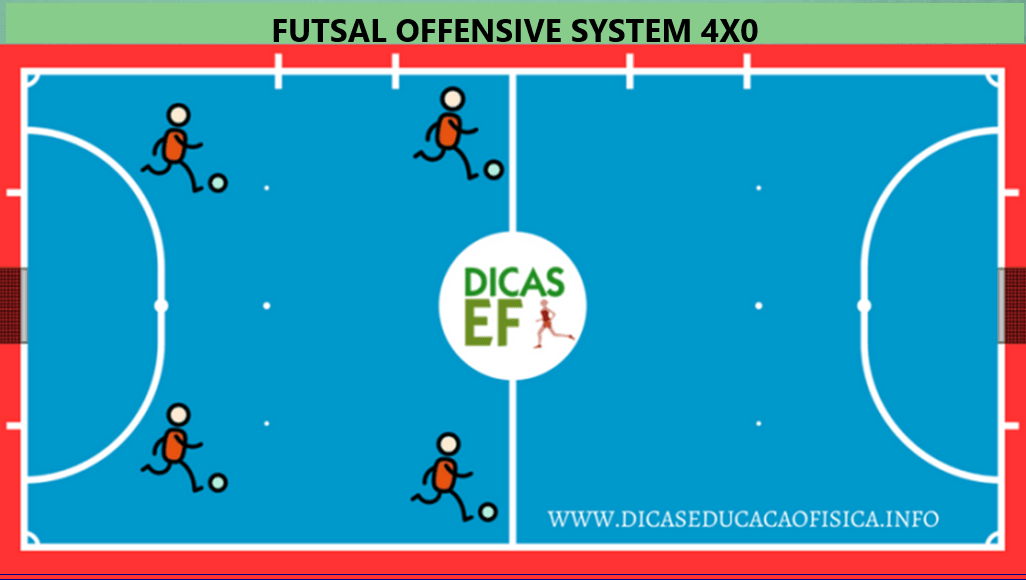
Advantages of the 4×0 System in Futsal
- Promotes a more dynamic movement of the team;
- Always allow passes options;
- Difficult for the opponent team to defend, due to great movement;
- Physically can be exhausting the defending team;
- The ball moves extremely fast;
- Great option to maintain possession of the ball;
- Facilitates the occupation of space;
- Best way to get out of pressure;
- Makes it difficult for opponent team to cover the whole field.
Disadvantages of the 4×0 System
- Everyone on the court MUST understand the system otherwise it will not work;
- Players must be extremely well conditioned physically;
- If players focus too much on movement, the team is predictable and not offensive;
- Players MUST be technically good;
- Players MUST be agile.
Futsal Offensive System 3×2
The Futsal 3×2 tactical system happens when the goalkeeper leaves his area to participate in his team’s attacking moves. Usually the goalkeeper is replaced by a regular player, to make his system more efficient offensively. With this formation the players do not change their position very often. They try to tire the defenders, passing the ball quickly in all corners of the court.
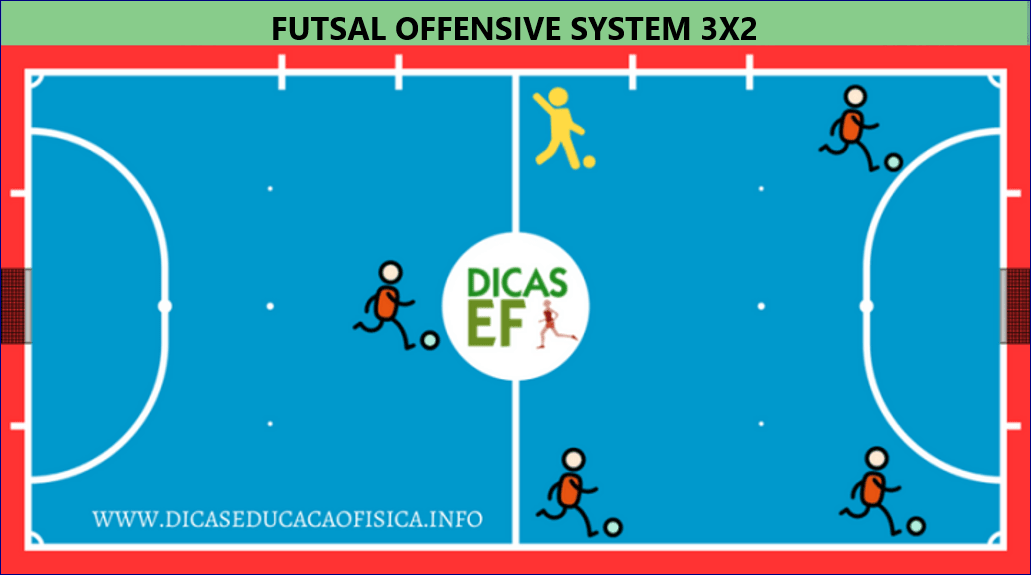
DETAIL: In the image above the Goalkeeper (in yellow) is positioned on the attacking court, this is because the Futsal Rule restricts the goalkeeper’s possession of the ball on the defense court, he cannot receive the ball more than once and cannot stay with it for more than 4 seconds (being in the backcourt).
Conheça Nossos Materiais
“In this formation it is important that the players have a lot of precision in the passes and expect a very clear opportunity to kick the ball towards the opponent goal, because a hasty shot or a wrong pass can be fatal, since the goalkeeper will be out of his goal.”
Advantages of the 3×2 System
- A numerical advantage is created when attacking;
- Enables the creation of clear finishing opportunities.
Disadvantages of the 3×2 System
- There is a great risk of suffering a counterattack goal, as the goalkeeper is out of his goal;
- The team can play with a non-specialist goalkeeper.
FUTSAL DEFENSIVE SYSTEM
What is the goal of Futsal defensive system?
A good Futsal defensive system is one that provides effective marking on the opposing team. The goal of Futsal marking is to prevent the opponent from making successful offensive plays, without committing fouls. The Futsal rules will punish the excess of fouls with direct free kick; therefore, marking must be efficient but not excessively aggressive.
Fouls and Futsal Defensive System
Having a good defensive system is the best way to avoid excessive fouls in a Futsal game. If athletes are well aware of their roles and defense positions, marking will be much more of a tactical issue than of aggression, and this will prevent an excessive number of fouls.
Physical Preparation and Futsal Defensive System
With the development of physical preparation, Futsal marking has also evolved a lot, as currently Futsal athletes can fill the spaces more efficiently. In addition, they are stronger and are able to better follow the opponents’ offensive moves.
Elements of the Futsal Defensive System
The defensive system of Futsal consists of the types of marking (how to mark), and of the defensive lines or defensive variations (where it is marked). A Futsal team can mark individually (man-to-man), by zone or by mixed zone.
Man Marking on Futsal
Man marking in futsal is the so-called “man-to-man marking”, i.e., each player will be assigned a specific opposition player to mark, in any part of the pitch.
Positive aspects of man marking:
- Hinders free kick (long kick);
- Descreases pass options;
- Forces the opponent to make mistakes;
- increases opponent’s physical exhaustion, as they need to make more moves in order to escape from marking;
- decreases the opponent’s ball possession time;
- decreases the opponent’s reaction time to think about which move to make.
Negative aspects of man marking:
- promotes great physical exhaustion to the defenders in order to keep up with the attacker’s moves;
- leaves mid-court free, making it easier for free kicks, ball-pass behind the defender;
- the opposing team may be in numerical advantage when they get a dribble, making it difficult for recovering and backing up.
Zonal Marking on Futsal
In zonal marking in Futsal, each defender is responsible for marking an area of the court, the opposing player that occupies that area will be marked. In zonal marking, the defender must not follow the opponent across the court, they must only follow the opponents who enter their marking zone. It is used when the opposing team has good moves, along with pass exchanges, or when the team is winning. For a good zonal marking, it is required intense training.
Positive aspects of zonal marking:
- makes it easier for backing up and recovering the ball in the case of a dribble;
- less physical exhaustion on defenders;
- provides good chances of counter attack;
- makes it harder to occur a ball-pass behind the defender and better-organizes mid-court.
Negative aspects of zonal marking:
- enables free kick (long kick);
- increases the time of ball possession of the opposing team;
- may partially hinder the goalkeeper’s vision.
Mixed Zonal Marking on Futsal
The mixed zone marking is the one that uses zone marking combined with man marking; it basically comes down to marking an opponent individually, while the other players are marked by zone.
Mixed Zonal Marking on Futsal
The mixed zone marking is the one that uses zone marking combined with man marking; it basically comes down to marking an opponent individually, while the other players are marked by zone.
Defensive System 2×2 or Square Formation
The defensive system 2×2 or Square formation is the type of marking used against teams that use the tactical system 2×2 or 4×0. Two players are positioned ahead and maintain their positions, only touching opponents who “enter” their zone. The two players in the back will mark the two most advanced players on the opposing team.
Defensive Lines and Defensive System of Futsal
The defensive lines in Futsal are associated with the idea of space; the more advanced the defensive line, the less space is left for the opposing team to play.
First defensive line
The first defensive line or line 1, is the one in the opponent’s defense court, close to the opponent’s goal, the so-called pressure marking, in order to prevent the opponent’s ball out. Thus, the first defensive line marking is a type of marking that leaves little room for the opponent to play.
Second Defensive Line
The second defensive line in Futsal or line 2 is the half-pressure type of marking. In this defensive position, the goalkeeper has a little more room to exit the ball, however, as soon as the ball is dominated by an opposing player, the team advances to the first line of defense, increasing the pressure in the marking.
Third Defensive Line
The third defensive line in Futsal or line 3 is the half-court type of marking, because in this defensive position, the team positions itself from the middle of the court, leaving the opponents unmarked in their defensive zone, but when the opponents enter the attack zone, they suffer strong marking. The aim of this defensive positioning is to avoid infiltration, “ball-pass from behind the defender”, to better organize mid-court and to play in the counterattacks.
Fourth Defensive Line
The fourth defensive line in Futsal or line 4 is a type of positioning defensive enough retracted, located near the line of 10 meters in the defense zone. In this system, the opposing team will have plenty of space to keep the ball, however, they will not have spaces for infiltrations or to play a one-two. The aim of this defensive positioning is also the counter-attack game.
 Material de Educação Física
Material de Educação Física